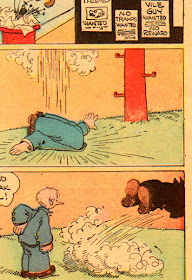An obscure screwball classic every Wednesday!
Presenting a run of 12 rare beautiful pre-Popeye Thimble Theatre comic strips from 1920. The first Thimble Theatre appeared December 19, 1919. E. C. Segar created thousands of Thimble Theatre episodes before Popeye appeared in the strip ten year later (Jan 17, 1929).
For these early strips, Segar kept his drawings simple and to the point. However, the strip is a sophisticated example of the art of humorous cartooning, much like Ernie Bushmiller's Nancy. Segar worked hard, and he was just plain great as a humorous cartoonist.
It was in the 1920's that Segar honed his craft. As you can see in these delightfully daffy dailies, he had an emphasis on screwball humor from the start. His strips sometimes end on flip takes, nutty behavior is the norm, and these little comics are packed with action and ideas.
Here's a nice little press biography of Segar that appeared in The Literary Digest, May 11, 1935.
 |
| The Literary Digest - May 11, 1935 |
The strips in this post are from Jan 1- Jan 14, 1920 -- some of the very first episodes of Thimble Theatre! You can see some of the beloved art elements used in the Popeye strips being brought into magical creation in these rare early comics. A few notes follow.
The original concept for Thimble Theatre was to present little parodies of popular movies and plays in serialized comic strip form. The imeptus for creating the strip was to replace Ed Wheelan's Midget Movies, which the syndicate had just lost when Wheelan was hired away to create hi smore well-known comic Minute Movies.
The strip below features "Harold Hamgravy," the proto-type for the more familiar "Ham Gravy" in a parody of the "perials of Pauline" type melodrama -- you know the kind, the one where the villain ties the heroine to the train tracks and cackles gleefully. Here, Segar is being fanciful and free with the "milky way" gag. Part of the joy of Segar's comics -- and screwball comics in general -- is that they make no attempt to duplicate reality, understanding that the sky is the limit in this medium.
 |
| Thimble Theatre by E.C. Segar - Jan 1, 1920 |
Olive Oyl is present from the start, as well!
 |
| Thimble Theatre by E.C. Segar - Jan 2, 1920 |
Hamgravy's shoes look like something from a Don Martin Mad one-pager!
 |
| Thimble Theatre by E.C. Segar - Jan 3, 1920 |
 |
| Thimble Theatre by E.C. Segar - Jan 5, 1920 |
 |
| Thimble Theatre by E.C. Segar - Jan 6, 1920 |
The strip below ends on a terrific "flip" or "plop" take. The way Segar draws his speech balloons is poetry.
 |
| Thimble Theatre by E.C. Segar - Jan 7, 1920 |
More funny labels and arrows.
 |
| Thimble Theatre by E.C. Segar - Jan 8, 1920 |
 |
| Thimble Theatre by E.C. Segar - Jan 9, 1920 |
 |
| Thimble Theatre by E.C. Segar - Jan 10, 1920 |
Substitute Popeye for Hamgravy and the strip will seem very familiar....
 |
| Thimble Theatre by E.C. Segar - Jan 12, 1920 |
A crazy invention for shooting around trees and corners. Starting with Rube Goldberg, screwball strips have a love affair with stupid inventions.
 |
| Thimble Theatre by E.C. Segar - Jan 13, 1920 |
This strip ends on another great flip take.
 |
| Thimble Theatre by E.C. Segar - Jan 14, 1920 |
12 Salesman Sam dailies by C.D. Small
4 Spooky Sundays by Bill Holman
3 Needlenose Noonan Sundays by Walter Hoban
3 Discontinued Stories by Walter Hoban
12 Thimble Theatres from 1920 by E.C. Segar
34 - TOTAL
That leaves 16 more screwball comics to go! More rare comics with logoes on the bogoes to come. Stay tuned!
This blog needs readers -- please spread the word. Let's bring screwball comics back!
Screwbally Yours,
Tall Pumey




































